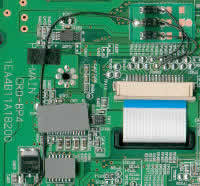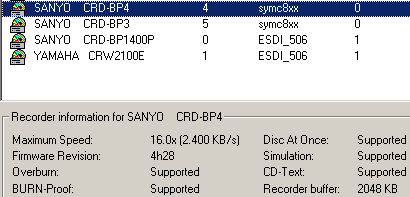Sanyo CRD-BP4-1400P CD-RW
1. First 16x CLV writing CDR-W drive!
Review Pages
2. Data Tests
3. RW reading tests
4. DAE Tests
5. CDR Tests
6. RW Writing Tests
7. Conclusion
The buffer underrun eliminator strikes again and ship first 16x CLV writing CDR-W drive!
- Introduction:
 Sanyo
has been the only manufacturer, which for a long time have leaded the race for
the fastest CDR-W drive until.. Yamaha decided to regain the lost ground and
ship the first 16x CDR-W drive. That made a quick huge impact among the users,
which had used Sanyo to be the leader of CD recording speed. The Yamaha's 16x
solution was not *real* 16x writer (CLV) but partial CAV which in theory takes
more time to finish the burn. Sanyo the next day after the official press release
of Yamaha CRW2100E announced their 16x solution to the public making user to
start wondering who will this time win. This time Yamaha has the lead since
their 16x solution is already available to users. Sanyo based 16x CDR-W drives
should be out in the first quarter of 2001.
Sanyo
has been the only manufacturer, which for a long time have leaded the race for
the fastest CDR-W drive until.. Yamaha decided to regain the lost ground and
ship the first 16x CDR-W drive. That made a quick huge impact among the users,
which had used Sanyo to be the leader of CD recording speed. The Yamaha's 16x
solution was not *real* 16x writer (CLV) but partial CAV which in theory takes
more time to finish the burn. Sanyo the next day after the official press release
of Yamaha CRW2100E announced their 16x solution to the public making user to
start wondering who will this time win. This time Yamaha has the lead since
their 16x solution is already available to users. Sanyo based 16x CDR-W drives
should be out in the first quarter of 2001.
- The features:
 Sanyo's Sanyo's 16x solution is real 16x (CLV) writer which in theory can burn
a full 74min CD under 5mins (including lead-in and lead-out time)! The drives
also support the HS RW writing standard (10x re-write) as well 40x reading speed
(which is not so real as you will notice later). The new Sanyo drives also include
the improved BURN-Proof version which now shrinks to 2-5nm ,when the original
BURN-Proof had 40n¥, the gap length. Last Sanyo added support for 90min CDs
and DAO-RAW writing (a long requested feature..). ¥¥e battle of the partial
CAV against full CLV writing mode started. Who will be the winner?
Sanyo's Sanyo's 16x solution is real 16x (CLV) writer which in theory can burn
a full 74min CD under 5mins (including lead-in and lead-out time)! The drives
also support the HS RW writing standard (10x re-write) as well 40x reading speed
(which is not so real as you will notice later). The new Sanyo drives also include
the improved BURN-Proof version which now shrinks to 2-5nm ,when the original
BURN-Proof had 40n¥, the gap length. Last Sanyo added support for 90min CDs
and DAO-RAW writing (a long requested feature..). ¥¥e battle of the partial
CAV against full CLV writing mode started. Who will be the winner?
- The package
 The
drives we got were pre-release OEM drives. That mean various companies which
ship similar drives based on the drives we have. There might be some changes
to the look of the drives but the inside will remain the same. Both drive uses
latest Sanyo's IC chipsets for BP4: LC 898023KW and for BP1400P: LC 898093KW.
If we take a closer look over the inside the most noticeable difference is an
extra cables at the BP4 model:
The
drives we got were pre-release OEM drives. That mean various companies which
ship similar drives based on the drives we have. There might be some changes
to the look of the drives but the inside will remain the same. Both drive uses
latest Sanyo's IC chipsets for BP4: LC 898023KW and for BP1400P: LC 898093KW.
If we take a closer look over the inside the most noticeable difference is an
extra cables at the BP4 model:
Below there is the front picture of the Sanyo CRD-BP4/1400P. We post only one picture since both drives share the same front:

 As
you can see the drive includes 2 leds (Busy, Write), the manual eject hole,
the headphone jack/volume control which most CD-Rom/RW drives have and 2 logos
- the "BPRec" and the High-Speed Recording logo. All BURN-Proof enabled
drives include the "BPRec logo". In the back you will notice some
differences due to ATAPI and SCSI interfaces. Below is the back picture of the
BP4 model which more or less is the same as the BP1400P Both drives have an
empty place for additional fan ;)
As
you can see the drive includes 2 leds (Busy, Write), the manual eject hole,
the headphone jack/volume control which most CD-Rom/RW drives have and 2 logos
- the "BPRec" and the High-Speed Recording logo. All BURN-Proof enabled
drives include the "BPRec logo". In the back you will notice some
differences due to ATAPI and SCSI interfaces. Below is the back picture of the
BP4 model which more or less is the same as the BP1400P Both drives have an
empty place for additional fan ;)

- Installation :
 The
installation was very easy. We left the default SCSI ID to 4 for BP4 and we
placed the BP1400P as master in the secondary IDE bus. After booting, the CDR-W
drives identified as Sanyo CRD-BP3 and CRD-1400P.
The
installation was very easy. We left the default SCSI ID to 4 for BP4 and we
placed the BP1400P as master in the secondary IDE bus. After booting, the CDR-W
drives identified as Sanyo CRD-BP3 and CRD-1400P.
 We
unchecked the Auto Insert notification, checked Sync Data Transfer
(for BP4), DMA (for BP1400P) and rebooted. Both drives were September
2000 models and came with 4.a28 (BP4) and 5.a28 (BP1400P) firmware revisions.
Sanyo provide us new firmware revisions 4.h28 (BP4) and 5.h28 (BP1400P), which
corrected several bugs with 90 and 99min CDs. Until the final drive comes out
there will be for sure several other firmware updates.
We
unchecked the Auto Insert notification, checked Sync Data Transfer
(for BP4), DMA (for BP1400P) and rebooted. Both drives were September
2000 models and came with 4.a28 (BP4) and 5.a28 (BP1400P) firmware revisions.
Sanyo provide us new firmware revisions 4.h28 (BP4) and 5.h28 (BP1400P), which
corrected several bugs with 90 and 99min CDs. Until the final drive comes out
there will be for sure several other firmware updates.
We used Nero 5.0.3.1 for all our burning tests and Ahead's InCD v1.70 for packet writing tests. There is a issue here since not many software managed to recognize the increased (16x) writing speed of the Sanyo drives (Padus DJ, Feurio..). Don't worry since soon both drives will be fully supported from most CDR software.
 -
Test Machine:
-
Test Machine:
WinMe OS
Soyo 7VCA
Celeron II 566 over clocked to 850 MHz
128MB SDRAM PC 133
WD 18GB UDMA 66
Quantum Fireball EX 6.4 GB UDMA 33
DAWI 2975 - PCI (ULTRA) SCSI Host Adapter
ATI AIW 128
Plextor UltraPlex 40max firmware v1.04
PlexWriter PX-W1210S firmware v1.00 (TLA#000)
Sanyo CRD-BP4 firmware v4.h28
Sanyo CRD-BP1400P firmware v5.h28
Yamaha CRW2100E firmware v1.0g
Review Pages
2. Data Tests
3. RW reading tests
4. DAE Tests
5. CDR Tests
6. RW Writing Tests
7. Conclusion













